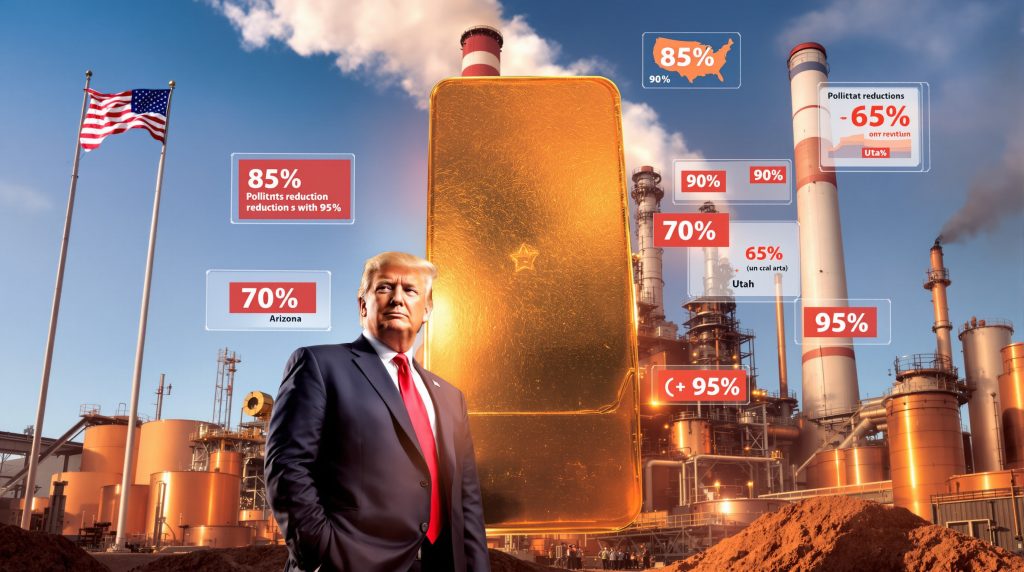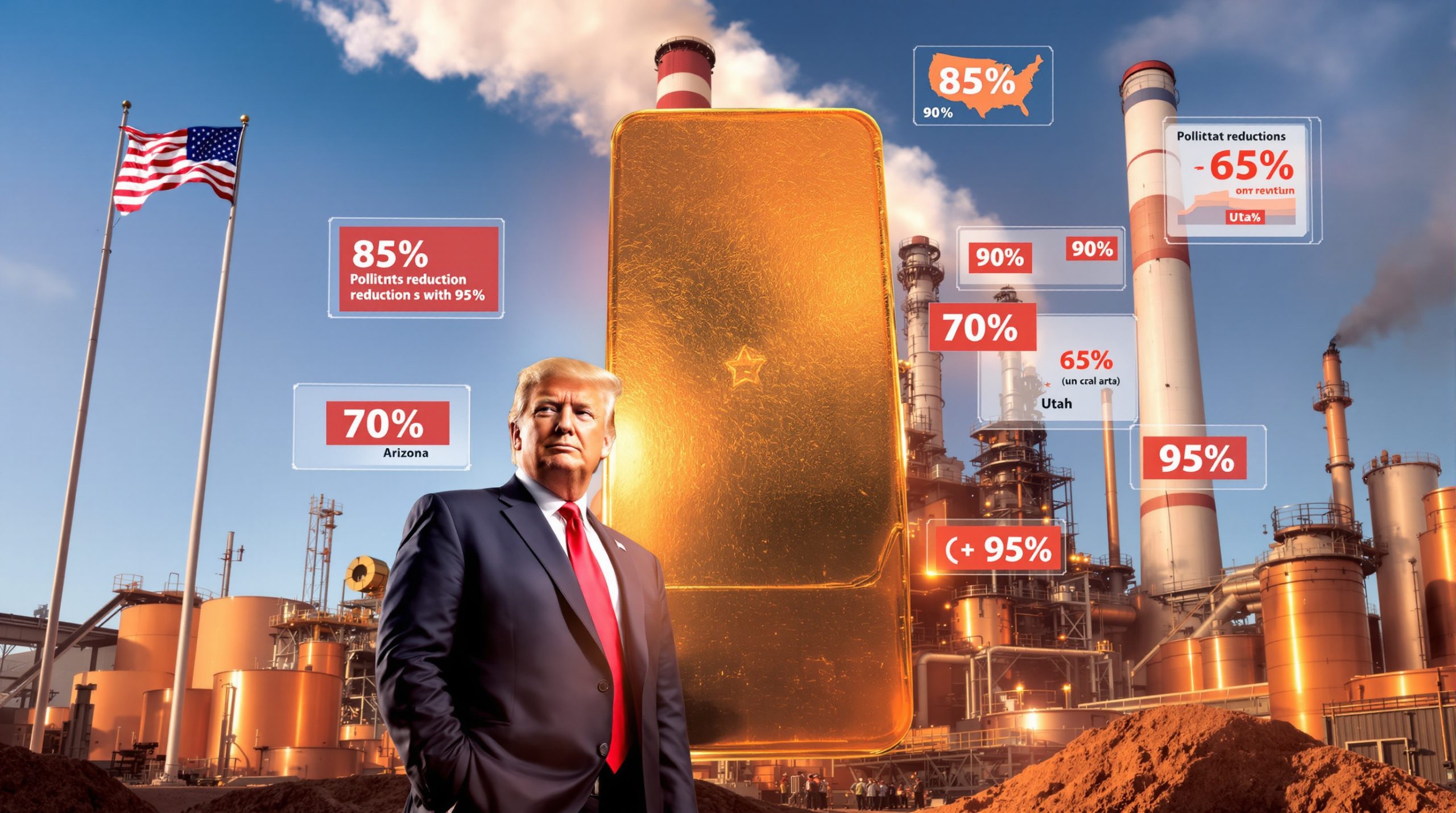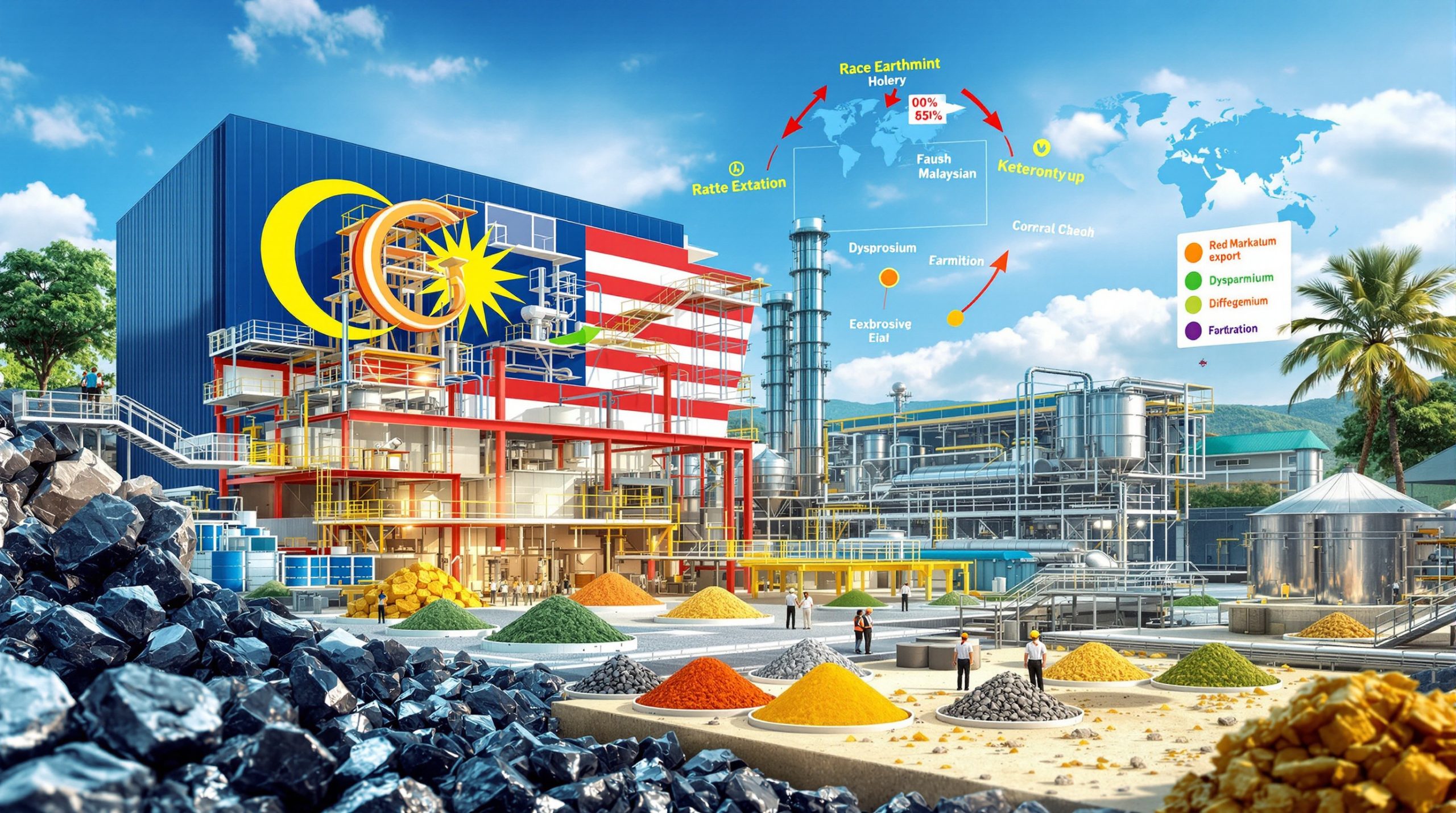Understanding the Biden Administration's Original Copper Rule
The Environmental Protection Agency established comprehensive air quality standards in May 2024, creating stringent requirements for copper smelting operations nationwide. These regulations targeted hazardous emissions that posed significant health risks to surrounding communities, mandating substantial reductions in toxic pollutants including lead, arsenic, mercury, benzene, and dioxins.
Industry analysts projected implementation costs ranging from $200-500 million per facility, depending on existing infrastructure and required technological upgrades. The original framework provided a three-year compliance window, with smelters required to install advanced emission control systems by 2027.
Key Pollutants Targeted by the Original Standards
The 2024 rule addressed five primary hazardous air pollutants with documented links to severe health complications:
• Lead exposure – Associated with neurological damage and developmental delays in children
• Arsenic emissions – Linked to increased cancer risk and cardiovascular disease
• Mercury releases – Causes brain and nervous system damage
• Benzene compounds – Connected to leukemia and blood disorders
• Dioxin contamination – Associated with cancer and reproductive system issues
The regulation represented an update to National Emission Standards for Hazardous Air Pollutants under Clean Air Act Section 112 authority, specifically targeting the limited domestic copper processing infrastructure.
Implementation Timeline and Compliance Expectations
The original regulatory framework established clear milestones for industry compliance:
-
2024-2025: Initial assessment and planning phase
-
2025-2026: Technology procurement and installation preparation
-
2026-2027: Full system deployment and testing
-
2027: Complete compliance achievement
Furthermore, specific reduction percentages for each pollutant were established in official EPA documentation from May 2024, providing clear targets for industry compliance.
What Prompted Trump's Executive Reversal Decision?
President Trump announced the Trump copper smelter emissions rule reversal on October 24, 2025, citing national security concerns and industrial competitiveness as primary justifications. The Trump executive order granted a two-year compliance exemption, arguing that stringent environmental standards threatened America's already constrained domestic copper processing capacity.
National Security Implications of Copper Production
The proclamation emphasised copper's designation as a critical material essential for multiple strategic sectors:
• Defence infrastructure and military equipment manufacturing
• Electric vehicle production and battery technology
• Renewable energy systems including solar panels and wind turbines
• Advanced telecommunications networks and data infrastructure
• Grid modernisation for distributed energy resources
According to the White House statement, imposing environmental requirements on such limited domestic industry risked accelerating facility closures, weakening the nation's industrial base, undermining mineral independence, and increasing reliance on foreign-controlled processing capacity.
Economic Justifications for Regulatory Relief
The Trump administration highlighted several economic factors supporting the regulatory exemption:
Limited Domestic Capacity: Only two operational copper smelters remain in the United States, representing the entirety of primary copper processing capability.
Technology Availability Concerns: Required emission control systems were characterised as lacking commercial viability within the original timeline.
Compliance Cost Burden: Implementation expenses could potentially force facility closures, eliminating domestic processing capacity entirely.
Foreign Dependency Risks: Increased reliance on Chinese-controlled processing capacity posed strategic vulnerabilities.
Industrial Base Protection: Preserving critical manufacturing capabilities took precedence over environmental timeline adherence.
Section 232 Investigation Connection
The copper smelter exemption built upon earlier Section 232 trade actions implemented in 2025. Following a national security investigation, the administration imposed Trump tariffs on copper stocks including a 50% tariff on certain imported copper products and mandated increasing percentages of high-quality scrap copper produced domestically be sold within US markets.
These coordinated policies demonstrated a comprehensive approach to reshoring copper processing capacity through both trade measures and regulatory relief. Moreover, the Trump tariffs economic impact extends beyond copper to influence broader industrial strategy.
Which Copper Facilities Are Affected by This Policy Change?
The regulatory exemption directly impacts America's remaining copper smelting infrastructure, representing critical industrial assets for domestic mineral processing.
Freeport-McMoRan's Arizona Operations
Freeport-McMoRan operates the nation's largest copper smelter in Miami, Arizona, processing approximately 400,000 tonnes of copper annually. The Phoenix-based company directly benefits from the two-year compliance exemption, providing operational certainty during regulatory uncertainty.
Company representatives expressed gratitude for the exemption, stating it acknowledges operational realities facing domestic copper smelting and provides needed time to assess and plan for appropriate regulatory reconsideration of the Copper Rule and future implementation.
Rio Tinto's Utah Kennecott Smelter
Rio Tinto's Kennecott operation in Utah processes roughly 300,000 tonnes annually but remains unaffected by the original 2024 regulations due to previous environmental investments. The company invested significantly in emission capture technology, achieving compliance ahead of the original timeline.
Rio Tinto emphasised their long-standing commitment to reducing environmental footprint through innovation and investment, highlighting equipment that captures emissions as the basis for regulatory compliance.
| Facility | Owner | Location | Annual Capacity | Exemption Status |
|---|---|---|---|---|
| Miami Smelter | Freeport-McMoRan | Arizona | 400,000 tonnes | Exempt |
| Kennecott Smelter | Rio Tinto | Utah | 300,000 tonnes | Compliant |
Combined US Processing Capacity
These two facilities represent approximately 700,000 tonnes of annual domestic copper processing capacity, highlighting the strategic importance of maintaining operational continuity in this limited industrial base.
How Does This Impact America's Copper Supply Chain Security?
The regulatory reversal reflects broader concerns about mineral independence and supply chain resilience, particularly given China's dominance in global copper processing markets and projected demand increases from clean energy transitions.
Global Copper Smelting Landscape
China controls approximately 50% of worldwide copper smelting capacity, creating strategic vulnerabilities for nations dependent on copper imports. The United States processes less than 5% of global copper despite significant domestic mining operations.
The US produces approximately 1.2 million tonnes of copper concentrate annually but can only process 700,000 tonnes domestically, requiring exports to foreign smelters for final processing of roughly 500,000 tonnes or 41% of domestic production.
Strategic Implications for Clean Energy Transition
Copper price insights indicate a 70% increase in demand by 2030 due to electrification trends and renewable energy deployment. This surge reflects multiple technological shifts:
• Electric Vehicle Manufacturing: Each EV requires 180-400 pounds of copper compared to 50 pounds in traditional vehicles
• Renewable Energy Infrastructure: Solar panels, wind turbines, and grid modernisation require substantial copper inputs
• Charging Infrastructure: EV charging networks demand extensive copper wiring and components
• Grid Integration: Distributed energy resources require upgraded transmission and distribution systems
Supply Chain Vulnerability Assessment
The structural deficit in domestic processing capacity creates several strategic risks:
-
Processing Dependency: 41% of US copper concentrate requires foreign processing
-
Geographic Concentration: China's 50% market share creates single-point-of-failure risks
-
Technology Transfer: Foreign processing potentially involves intellectual property exposure
-
Price Volatility: Limited domestic capacity reduces negotiating leverage in global markets
-
Security of Supply: Geopolitical tensions could disrupt processing access
What Are the Environmental and Health Consequences?
Environmental advocates express significant concern that the Trump copper smelter emissions rule reversal delays critical public health protections, particularly for communities surrounding copper smelting facilities where residents face continued exposure to hazardous emissions.
Air Quality Impact Assessment
The two-year compliance exemption maintains current emission levels rather than implementing the substantial reductions mandated under the original rule:
• Continued Carcinogenic Emissions: Lead, arsenic, and benzene releases persist at current levels
• Delayed Technology Implementation: Advanced emission control systems remain uninstalled
• Extended Community Exposure: Residential areas near smelters continue experiencing current pollution levels
• Postponed Air Quality Improvements: Regional atmospheric conditions show no immediate improvement
Community Health Considerations
Historical data indicates elevated rates of respiratory illness, cardiovascular disease, and developmental disorders in areas surrounding copper smelters. The exemption extends these exposure patterns for an additional 24 months beyond the original compliance timeline.
Affected Population Areas:
• Miami, Arizona: Communities surrounding the Freeport-McMoRan facility
• Utah Region: Areas near the Rio Tinto Kennecott smelter (though this facility achieved compliance)
Health Impact Valuation
According to Reuters reporting, the exemption period maintains exposure to substances with documented health effects, including neurological damage from lead exposure, cancer risks from arsenic and benzene, and reproductive system impacts from dioxin contamination.
Specific epidemiological studies and health outcome data for these communities require verification through CDC, EPA, or state health department publications to provide accurate baseline health metrics and projected impacts of the compliance delay.
How Do Industry Stakeholders View This Regulatory Change?
The copper industry generally welcomed the exemption while environmental groups criticised the prioritisation of economic concerns over public health protections, creating distinct perspectives on the regulatory balance.
Mining Industry Perspective
Industry representatives argue the original three-year timeline was unrealistic given technological limitations and capital requirements. Key industry positions include:
Technology Feasibility Concerns: Available emission control systems lacked commercial viability within the proposed timeframe.
Capital Investment Constraints: Implementation costs ranging from $200-500 million per facility posed significant financial burdens.
Closure Risk Assessment: Regulatory compliance costs could force facility shutdowns, eliminating domestic processing capacity entirely.
Strategic Security Arguments: Complete reliance on foreign operations would compromise national security interests.
Company-Specific Responses
Freeport-McMoRan thanked the Trump administration, characterising the exemption as acknowledging operational realities facing domestic copper smelting while providing needed time for regulatory reconsideration and future implementation planning.
Rio Tinto emphasised their commitment to reducing environmental footprint through innovation and investment, noting their Utah operation's compliance due to previous emission capture equipment investments.
Environmental Group Response
Environmental organisations contend the reversal undermines EPA authority and delays necessary health protections. Their primary arguments include:
• Regulatory Authority Erosion: Presidential exemptions weaken environmental agency effectiveness
• Public Health Prioritisation: Economic considerations should not supersede community health protections
• Technology Availability: Emission control solutions exist but require regulatory pressure for implementation
• Environmental Justice: Communities near smelters disproportionately bear health risks
What Happens During the Two-Year Exemption Period?
The exemption provides breathing room for industry and regulators to develop feasible compliance pathways while maintaining domestic smelting operations, creating opportunities for technological innovation and regulatory reassessment.
Technology Development Timeline
Expected developments during the 2025-2027 exemption period include:
Q1 2026: Formation of industry-EPA working groups to assess technological feasibility and alternative compliance pathways.
Q2 2026: Comprehensive technology feasibility assessments examining available emission control systems and their commercial viability.
Q3 2026: Implementation of pilot programmes testing emission reduction technologies at operational scales.
Q4 2026: Updated cost-benefit analyses incorporating technological developments and economic impacts.
2027: Proposal of revised regulatory framework balancing environmental protection with industrial competitiveness.
Investment and Innovation Opportunities
The delay period may encourage private sector investment in emission control technologies, potentially creating more cost-effective solutions than those available during original rule development. In addition, copper investment strategies may evolve to account for regulatory changes.
Technology Innovation Areas:
• Advanced filtration systems for particulate matter control
• Chemical scrubbing technologies for gaseous pollutant removal
• Process modification techniques reducing emission generation
• Monitoring and control systems for real-time emission management
• Energy recovery systems offsetting compliance costs
Regulatory Reassessment Process
The exemption period allows comprehensive evaluation of:
-
Technical Feasibility: Actual availability and performance of emission control technologies
-
Economic Impact: Precise compliance costs and their effect on facility viability
-
Alternative Approaches: Graduated compliance timelines or performance-based standards
-
International Best Practices: Emission control strategies employed by other copper-producing nations
-
Technology Development: Emerging solutions that may reduce compliance costs or improve effectiveness
What Are the Broader Implications for Mining Regulation?
This regulatory reversal signals a shift toward balancing environmental protection with industrial competitiveness, potentially influencing future mining and processing regulations across critical mineral supply chains.
Precedent for Critical Mineral Industries
The copper smelter exemption establishes a framework for addressing regulatory challenges across critical mineral supply chains, particularly where domestic processing capacity is limited and national security implications exist.
Potential Applications:
• Lithium Processing: Domestic battery-grade lithium production faces similar capacity constraints
• Rare Earth Element Refining: Limited US rare earth processing creates foreign dependency
• Battery Metal Processing: Nickel, cobalt, and manganese processing capacity remains underdeveloped domestically
• Uranium Enrichment: Nuclear fuel processing involves both environmental and security considerations
Future Regulatory Approach
The Trump administration's approach suggests prioritising domestic production capacity preservation while seeking technological solutions that balance environmental and economic objectives.
Key Regulatory Principles:
National Security Integration: Environmental regulations evaluated through security impact assessments.
Industrial Base Protection: Regulatory timelines adjusted to prevent facility closures in critical sectors.
Technology Development Support: Exemption periods used to advance emission control innovation.
Graduated Implementation: Phased compliance timelines based on technological and economic feasibility.
International Competitiveness: Regulatory costs balanced against global market positioning.
Legislative and Regulatory Implications
This precedent may influence Congressional approaches to environmental regulation, particularly regarding critical minerals designated under various strategic initiatives. Future legislation might incorporate explicit national security exemptions or alternative compliance pathways for strategically important industries.
Potential Policy Developments:
• Critical Minerals List Updates: Expanded designation of materials subject to security-based regulatory relief
• Alternative Compliance Mechanisms: Performance-based standards rather than technology-specific requirements
• Technology Development Incentives: Federal support for emission control innovation in strategic sectors
• International Coordination: Cooperative approaches with allies to maintain environmental standards while preserving strategic capabilities
Conclusion: Balancing Security and Environmental Protection
Trump's copper smelter emissions rule reversal reflects complex tradeoffs between immediate environmental benefits and long-term strategic security considerations. The two-year exemption creates opportunity for stakeholders to develop solutions protecting both public health and domestic industrial capacity.
The decision highlights fundamental tensions between environmental protection and national security priorities, particularly in sectors with limited domestic capacity and high strategic importance. The outcome will likely establish precedents for regulating critical mineral industries, balancing environmental standards with competitive positioning in global supply chains.
Key Considerations Moving Forward:
The success of this approach depends on whether the exemption period generates meaningful technological innovations and regulatory solutions. Environmental advocates will monitor health outcomes in affected communities, while industry stakeholders will assess technological feasibility and economic viability of eventual compliance requirements.
The broader implications extend beyond copper processing to encompass America's entire critical minerals strategy, influencing how policymakers balance environmental protection with strategic industrial capacity preservation in an increasingly complex geopolitical environment.
Disclaimer: This analysis reflects policy developments as of October 2025. Future regulatory changes, technological developments, or geopolitical shifts may alter the strategic calculations underlying these decisions. Environmental and health impact assessments should be verified through official EPA, CDC, and state regulatory agency publications.
Looking to Capitalise on Critical Minerals Policy Changes?
Discovery Alert's proprietary Discovery IQ model delivers real-time alerts on significant copper and critical minerals discoveries across the ASX, transforming complex regulatory shifts and market developments into actionable investment insights. Explore how major mineral discoveries can generate substantial returns by visiting Discovery Alert's dedicated discoveries page, then begin your 30-day free trial to position yourself ahead of policy-driven market movements.




